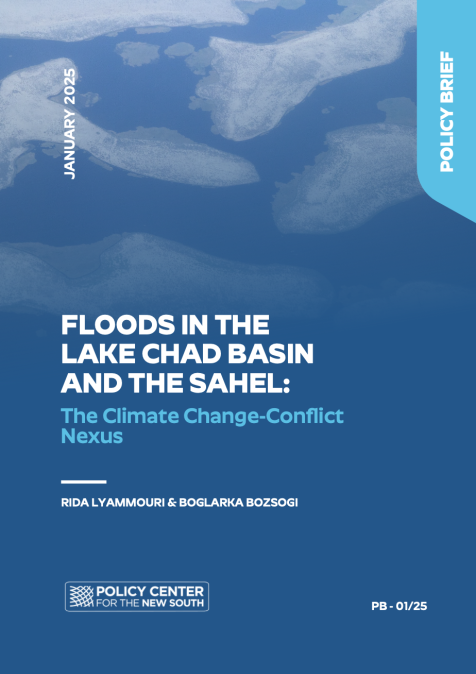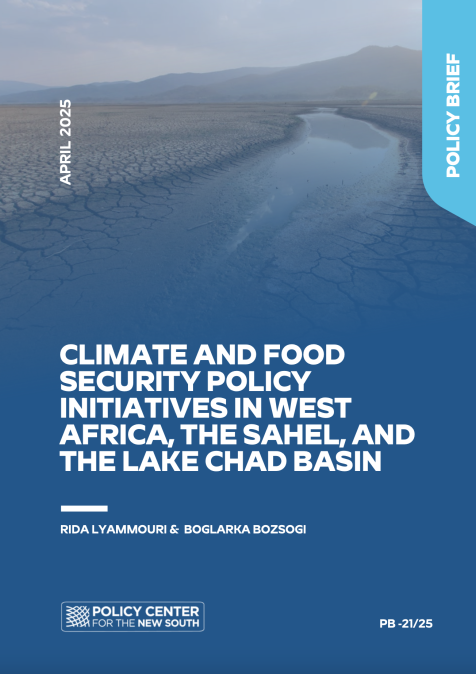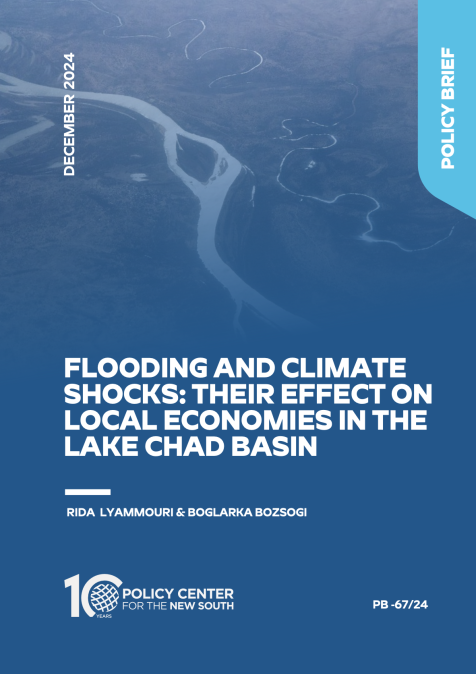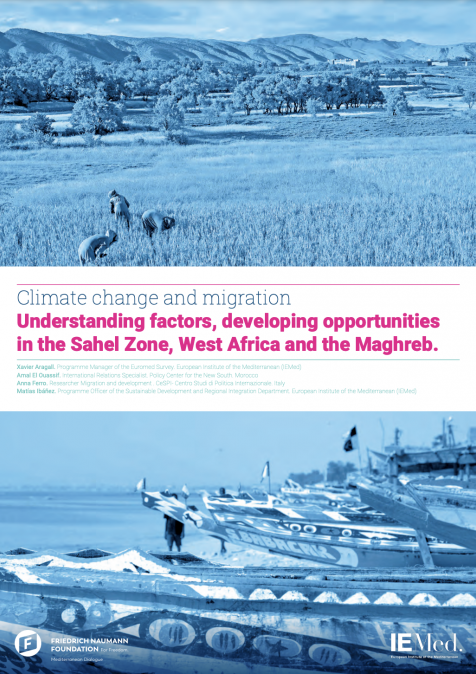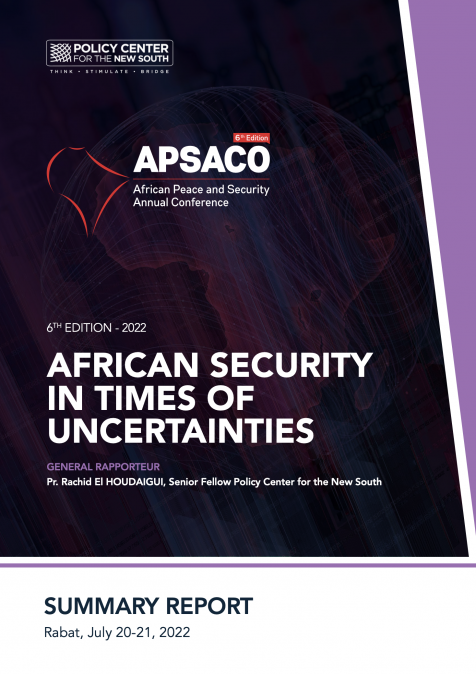Publications /
Policy Brief
The Lake Chad Basin and the Sahel regions have faced multidimensional conflict since 2011. Violence, attributed mostly to violent extremist organizations (VEOs) affiliated to al-Qaeda and the Islamic State, has put both regions on the global map of the deadliest armed conflicts and worst humanitarian crises. Since 2012, tens of thousands of people have been killed, while at least six million people have been displaced in the two regions combined. Simultaneously, floods since August 2024 have added to the stress felt by local populations already in dire humanitarian crisis, and have raised concerns that ongoing conflicts will intensify. Climate shocks add stress to conflict-affected local communities but do not necessarily intensify ongoing conflicts. Recent studies have concluded that the link between climate change and violent conflicts in the Sahel and Lake Chad Basin remains vague and questionable. However, this is not to say that climate change does not have consequences for local economies, ecosystems, and food security.
Introduction
The Sahel and Lake Chad Basin regions have endured deadly and multidimensional armed conflicts for more than a decade. The countries of the Sahel region—Niger, Mali, and Burkina Faso—have witnessed alarming levels of violence since 2011, with an increase in 2023 and 2024. Violent extremist organizations (VEOs) remain the main perpetrators of violence, though other actors, including state forces and ethnic militias, also contribute to ongoing conflicts. In the Lake Chad Basin, parts of Nigeria, Niger, Chad, and Cameroon around the lake have seen similar acts of violence by VEOs since 2010. In both regions, the ongoing conflicts have mostly affected civilians. Thousands of civilians have been killed, while at least six million people have been forced to flee their homes[1], [2]. Since August 2024, the populations of both regions have been struggling to cope with further crisis: flooding.
In the Lake Chad Basin and Sahel countries directly affected by recent flooding, the situation is compounded by conflict and displacement, with serious humanitarian consequences. Questions are being raised again about the relationship between climate change and conflicts. This policy briefs revisits existing literature on climate change-conflict nexus. It is based on open-source research and interviews with members of communities affected by recent floods in Mali, Niger, Cameroon, and Chad. This policy brief is the third in a series of briefs exploring the nexus of climate change with migration, displacement, and mobility, and local economies and livelihoods.
Climate Change-Violent Conflict Narrative
The dominant narrative links heightened violence to a changing climate. “It is assumed that higher temperatures in the Sahel are producing more droughts and floods, which in turn jeopardize agricultural production, increase poverty and fuel ethnic violence. Armed groups, particularly jihadists, are said to exploit these tensions to draw in recruits”[3]. Droughts and floods create pressure and jeopardize agriculture production, an economic activity the people in the Lake Chad Basin and the Sahel depend on. But generalizations that climate change leads to conflict can result in errors in policy and programming strategies. Fluctuating precipitation and extreme weather are not new to the Lake Chad Basin and the Sahel; locals have been adapting to unique regional climatic conditions in diverse ways. For instance, seasonal transhumance is proven to be the most resilient livelihood production model, which in addition has the power to regreen desertified ecosystems by integrating animals into drylands[4].
Climate shocks do lead to displacement as people are forced to leave in search of access to basic services and food security. A narrative among international donors when this occurs is that tensions and violent conflicts are possible between host communities and displaced people. But in a series of interviews, host and displaced families in Mali, Niger, Chad, and Cameroon all disagreed[5]. They insisted instead that moments of crisis are when communities show solidarity, despite limited resources. One displaced person in Niger stated: “No, it is not possible to anticipate tensions between the displaced and the host communities since the communities have the mercifulness and solidarity to welcome the displaced, as we have seen during the Boko Haram conflict where these communities welcomed these displaced people.” A displaced person in Mali also added: “From our arrival to our days, no one has touched us, and we don't think anyone will be hurt. We wouldn't want that to happen.”
Simultaneously, participants raised concerns about possible tensions over access to land. It is currently difficult to anticipate conflicts over land since water covers much of the land available for farming and herding. However, respondents suggested that once water levels return to normal, farmers and herders might compete over land. A displaced person in Mali stated: “Herders are faced with the difficulty of finding food in flooded areas in the same way as farmers are struggling to cultivate the land. Indeed, everyone is looking for each other right now but as the water starts to dry the grass will grow. At this time, the herders would return and perhaps the tensions would emerge”[6].
The Scarcity Myth
Research warns that the argument that a warming planet causes resource scarcity and in turn violence does not hold, and can even mislead policy efforts. Resource scarcity is not what accelerates insecurity. Rather, it is governance. In some places in the Sahel, conflicts and killings proliferate in the wet season, times of relative abundance, and dwindle in the dry season, as during times of relative scarcity, people may try to reconcile and cooperate. It is documented that periods of scarcity can trigger collaborative action and arrangements instead of conflict[7].
The climate crisis has contributed to the discord between pastoral and farming communities and production systems, but is not solely to blame. Since the Sahelian droughts of the 1970s and 1980s, the region has been fragile. This period was the origin of the marginalization of Fulani herders, who lost much of their livestock and became impoverished relative to sedentary farmers who started investing in livestock and employing pastoralists, gaining a perceived economic superiority. Governmental prioritization of food autonomy and agricultural modernization, mechanization, and intensification, substantiated by population growth, resulted in the expansion of farmland to the detriment of pastures. Participants interviewed believe there is correlation between the proliferation of conflicts in the Sahel and the transformation of production systems, which leads to poorly regulated competition for increasingly coveted resources—land in particular. Paradoxically, while arable land in Sahelian countries is shrinking each year as a result of climate change, the areas under cultivation continue to expand, along with production itself[8].
In the Lake Chad Basin, irregular rainfall and extreme weather put pressure on farming and livestock herding, two key means of livelihood for the region’s population. However, the region’s main challenge remains violence and conflict caused by VEOs. While local communities historically developed adaptive methods in response to climate shocks, the ongoing violent conflicts linked to VEOs is challenging those mechanisms. For instance, because of insecurity, herders are unable to travel freely to find vegetation for their herds. As regional governments impose states of emergency and curfews, and tighten border crossings, traders and seasonal workers finding it increasingly difficult to cross borders to neighboring countries to conduct trade and to find seasonal work.
The policy instinct is to respond to resource scarcity by providing more abundant resources, but this is unlikely to resolve tensions or tackle root causes. Experiences in the Sahel and the Lake Chad Basin suggest that resource abundance only incites more tension, competition, and conflict. Instead, equitable resource management and governance, providing space for pastoralists without forcing farmers off their land—for example through the integration of animals into cropland by regenerative agriculture and holistic management—are needed to mediate access to land and resource distribution[9].
The Potential of Good Governance
Historically, in Mali for instance, the government and international donors have favored farmers over nomads, encouraging settlement and aiding densely populated farmland areas. Changing transhumance routes in response to climatic and rainfall changes create friction over access to land and water, in competition with farms. In this sense, climate change aggravates or triggers conflicts that originate in historical grievances driven by governance neglect or injustice. But these conflicts are not the result of the climate crisis per se, but of historical government policies and societal practices that have discriminated against the Fulani, building inequality, marginalization, and a sense of injustice. Consequently, land-access and user rights stand out as critical questions to be solved in the climate-conflict nexus[10].
Similar dynamics can be seen in the deadly fighting between Choa Arab and Musgum groups in the Far North of Cameroon. Here Musgum fishers and farmers compete with Choa Arab cattle owners for access to water basins and floodplains. Chieftains and local administrators tend to favor the Choa Arabs, building on age-old frictions between sedentary, nomadic, and semi-nomadic groups in the region. At the same time, interchanging floods and droughts are diminishing soil fertility and thus harvests, putting communities in a precarious, food- and water-insecure situation. Economic vulnerability and VEO-related conflict force people to leave. Floods uprooted 20% of the 700,000 displaced people registered in 2023 from northern Cameroon; the other 80% fled from jihadist violence. Here too, the key lies in governance. Poor land and water management, outdated land laws and practices, widespread corruption, and the resulting confusion and mistrust exacerbate climate impacts on natural resources[11].
These dynamics also impact women and girls. In Cameroon, women of both communities lack rights to buy and manage land and water in a patriarchal system. They are excluded from decision-making that directly involves their activities, and from ownership rights, despite their work on the land and waterways. In some areas of the Far North region, women and children have to walk eight kilometers to fetch water, which likely contributes to the low literacy rates, particularly of girls[12]. In the Lake Chad region of Chad too, women and girls face sexual, physical, and psychological violence, in addition to structural disadvantages arising from restricted access to land, ownership, education, and justice[13]. In the Lake Chad Basin, recent studies have advocated for development and infrastructure support for rural communities around the lake, to reinforce existing adaptive mechanisms[14]. This support might not fully address the challenges of climate shocks, but likely to assist local women and population in general confront the stress caused by ongoing violent conflict in the area. Additionally, could improve working conditions for women, and youth making the living from working in farming.
The relationship between climate change and violent conflicts is complex, and it is almost impossible to directly link the two. However, exacerbating tensions from resource mismanagement, the climate crisis can contribute to tensions. Violent conflict and food insecurity are mutually reinforcing. Conflict and war destroy farmland, means of production, goods, and laborers, crippling food production and distribution, and thus food sovereignty and food security. “Violent conflict can have lasting negative effects on food systems, not least because most countries emerging from conflict need decades to recover”[15]. Meanwhile, research has traced how food insecurity (primarily rising prices of staples and reduced stocks), and the resulting instability and grievances, generate social unrest[16]. Armed groups tap into these grievances to formulate narratives of injustice, or to offer service provision that meets the needs of populations. In this way, militias—often extremist groups—use socioeconomic vulnerability for recruitment and revenue generation[17]. In line with this logic, local intelligence draws a straight line from climate change to radicalization: “Without a doubt, the floods in the villages will risk exacerbating tensions. The frustrations of young people seeing how their parents are abandoned to their own devices without any help, without hope of a better tomorrow... Risk leading them to radicalization”[18].
In sum, the climate crisis intensifies interrelated dynamics of economic insecurity, displacement, and conflict, insofar as it catalyzes feedback cycles among them, which become hard to break out of. Only with systemic policy approaches to rectify structural faults can these cycles be broken. State capacity and response has lots of leverage to address these needs head on and prevent escalation.
Policy Recommendations
- Invest in case studies to prevent the wrong assumptions being made. Climate shocks often lead to displacement, and at times there is the assumption of possible tensions and conflict between displaced people and host communities. A community leader in Ségou region stated, when asked about that: “I don't think so. If that's the case, those who welcomed them [displaced people] would not have welcomed them. I don't have an idea of that from my own experience. To the least extent you can go with more in-depth studies as a researcher to demonstrate it. We are also waiting for similar studies to shed more light on such cases. The results can frankly be useful to everyone, it would be encouraging to do so.” Solidarity between displaced and host communities is a source of social cohesion, unity, and resilience to be reinforced, rather than regarded as a possible problem.
- Climate change is unlikely to feature as a priority in the Sahelian and Lake Chad Basin countries because of the ongoing security situation and conflict with VEOs. Therefore, in the short-term, national, and international parties should still seek jointly and remain engaged to provide assistance to affected communities to limit the stresses caused by climate shocks. Assistance would help prevent further displacement and reduce the chance of tensions arising, and of competition over land and resources.
- Women in Lake Chad Basin and the Sahel are well involved in small-scale farming activities, and contribute to household incomes. Climate shocks, such as floods, have direct negative consequences for women in particular, and put them at risk of displacement and exploitation. National and international actors should implement measures to develop women’s capacities and relevant new skills, enabling them to find alternative livelihoods during climate shocks.
Conclusion
Violent conflicts caused by VEOs have devasted the communities of Lake Chad Basin and the Sahel regions for more than a decade. Recent floods have added to the crisis and forced hundreds of thousands of people to leave their homes. This climate shock (floods) raises concerns and questions about whether ongoing conflicts will intensify and/or new conflicts will emerge. While these concerns are genuine, and climate change is a possible factor that contributes to conflicts, the literature indicates that this link between climate change and conflict remains complex, vague, and questionable.
Simultaneously, climate shocks such as recent floods, do cause stress, and this is more apparent among communities living in conflict-affected areas. The assumption that this stress automatically leads to tensions and conflicts is misleading. For instance, interviews conducted indicated that communities are more likely to show solidarity toward each other, rather than to fight. Despite limited resources, host communities tend to demonstrate sympathy and support toward displaced populations, rather than seeing them as competition and a threat to existing resources. Nevertheless, concerns remain when competition arises over land when it becomes available for farmers and herders after flooding, as both groups seek to exploit the land. While this is a concern, it is also an opportunity for state actors to demonstrate good and fair governance that benefits everyone.
[1] Reliefweb, “Situation in Central Sahel, Liptako Gourma and Coastal Countries - DTM Monthly Dashboard #53 (September 2024),” 11 October 2024, https://reliefweb.int/report/burkina-faso/situation-central-sahel-liptako-gourma-and-coastal-countries-dtm-monthly-dashboard-53-september-2024#:~:text=The%20crisis%20has%20triggered%20significant,which%2034%2C088%20were%20internally%20displaced.
[2] OCHA, “Lake Chad Basin: Humanitarian Snapshot (as of 16 October 2024),” 18 October 2024, https://www.unocha.org/publications/report/nigeria/lake-chad-basin-humanitarian-snapshot-16-october-2024
[3] Signe Marie Cold-Ravnkilde and Boubacar Ba, “A Future of Climate Wars in the Sahel?” Unpacking ‘New Climate Wars’: Actors And Drivers Of Conflict In The Sahel, Danish Institute for International Studies, 2022. http://www.jstor.org/stable/resrep41506.8.
[4] Signe Marie Cold-Ravnkilde and Boubacar Ba, “A Future of Climate Wars in the Sahel?”
[5] Interviews with host and displaced families in Niger, Mali, Chad, and Cameroon, October 2024.
[6] Interviews in Ségou region, Mali, October 2024.
[7] Signe Marie Cold-Ravnkilde and Boubacar Ba, “A Future of Climate Wars in the Sahel?”
[8] International Crisis Group, “The Central Sahel: Scene of New Climate Wars?,” April 24, 2020, https://www.crisisgroup.org/africa/sahel/b154-le-sahel-central-theatre-des-nouvelles-guerres-climatiques.
[9] International Crisis Group, “The Central Sahel: Scene of New Climate Wars?.”
[10] Signe Marie Cold-Ravnkilde and Boubacar Ba, “A Future of Climate Wars in the Sahel?”
[11] International Crisis Group, “Curbing Feuds over Water in Cameroon’s Far North,” April 25, 2024, http://www.jstor.org/stable/resrep59609.
[12] International Crisis Group, “Curbing Feuds over Water in Cameroon’s Far North.”
[13] Kheira Tarif, Climate Change and Violent Conflict in West Africa.
[14] Okpara, U.T., Stringer, L.C. & Dougill, A.J. Lake drying and livelihood dynamics in Lake Chad: Unravelling the mechanisms, contexts and responses. Ambio 45, 781–795 (2016). https://doi.org/10.1007/s13280-016-0805-6
[15] Caroline Delgado, Kristina Tschunkert, and Dan Smith. “Food Insecurity in Africa: Drivers And Solutions.
[16] Caroline Delgado, Kristina Tschunkert, and Dan Smith. “Food Insecurity in Africa: Drivers And Solutions.
[17] Kheira Tarif, “Climate Change and Violent Conflict in West Africa.”
[18] Interview with displaced person in northern Cameroon, October 2024.

